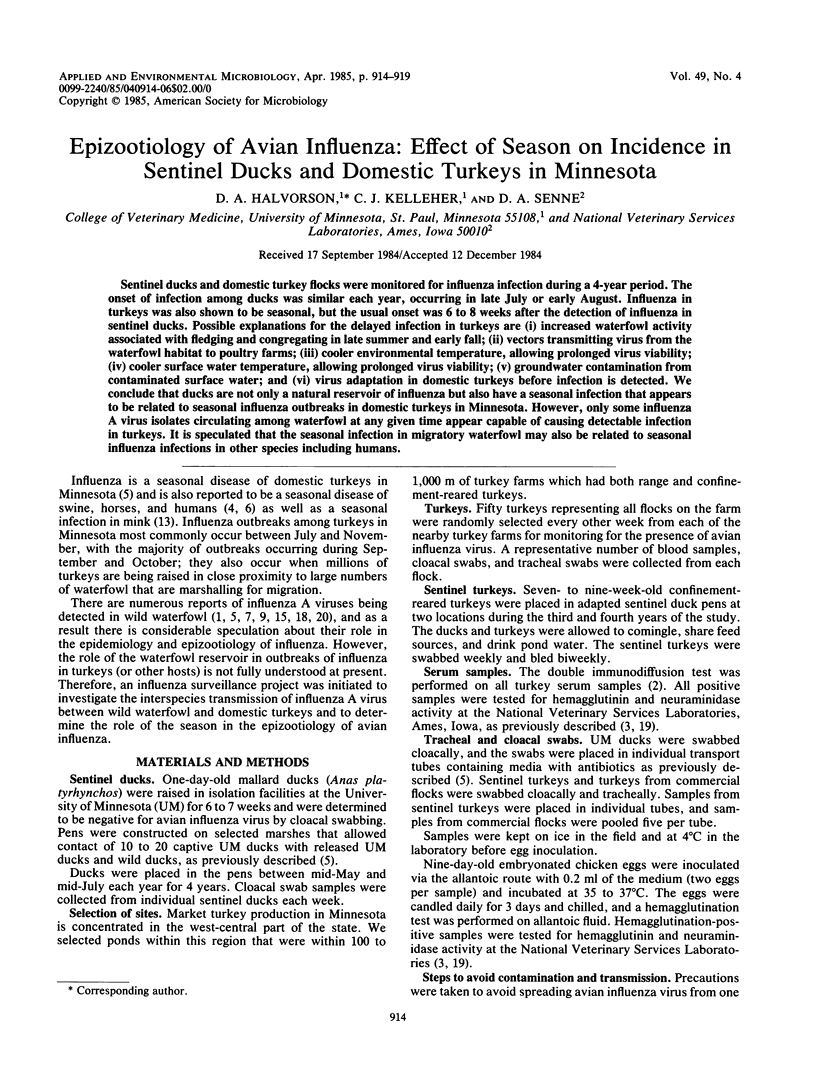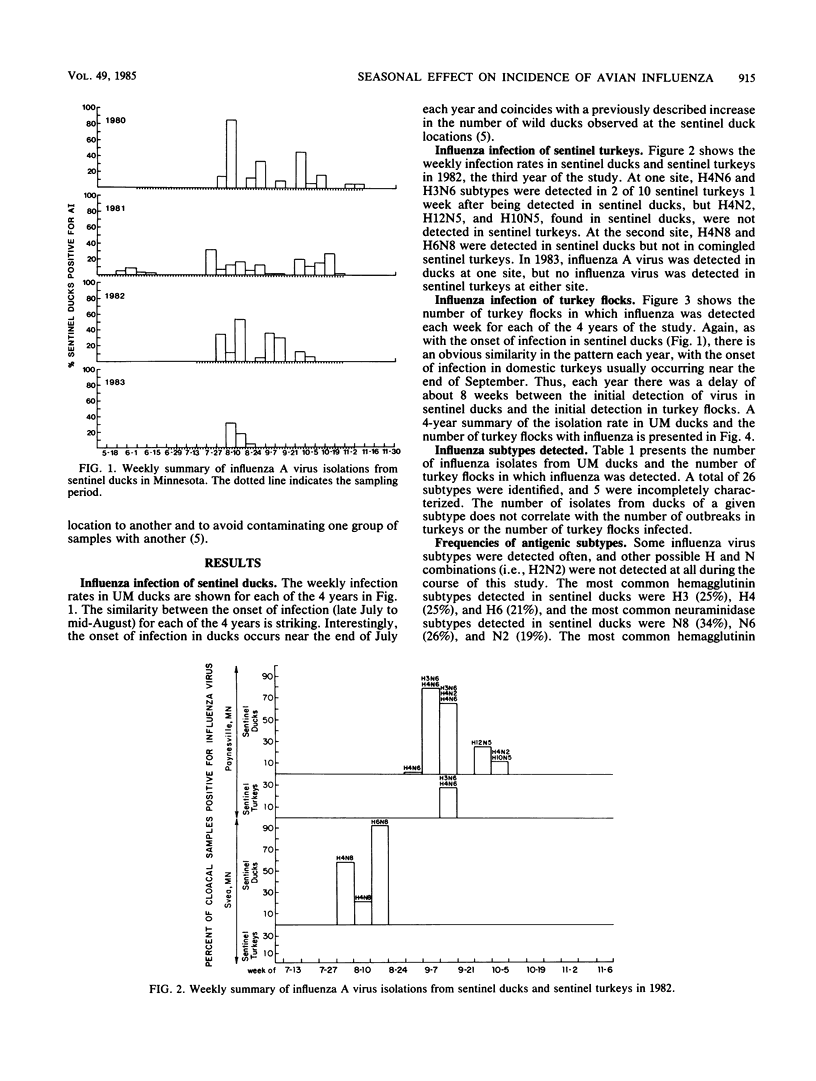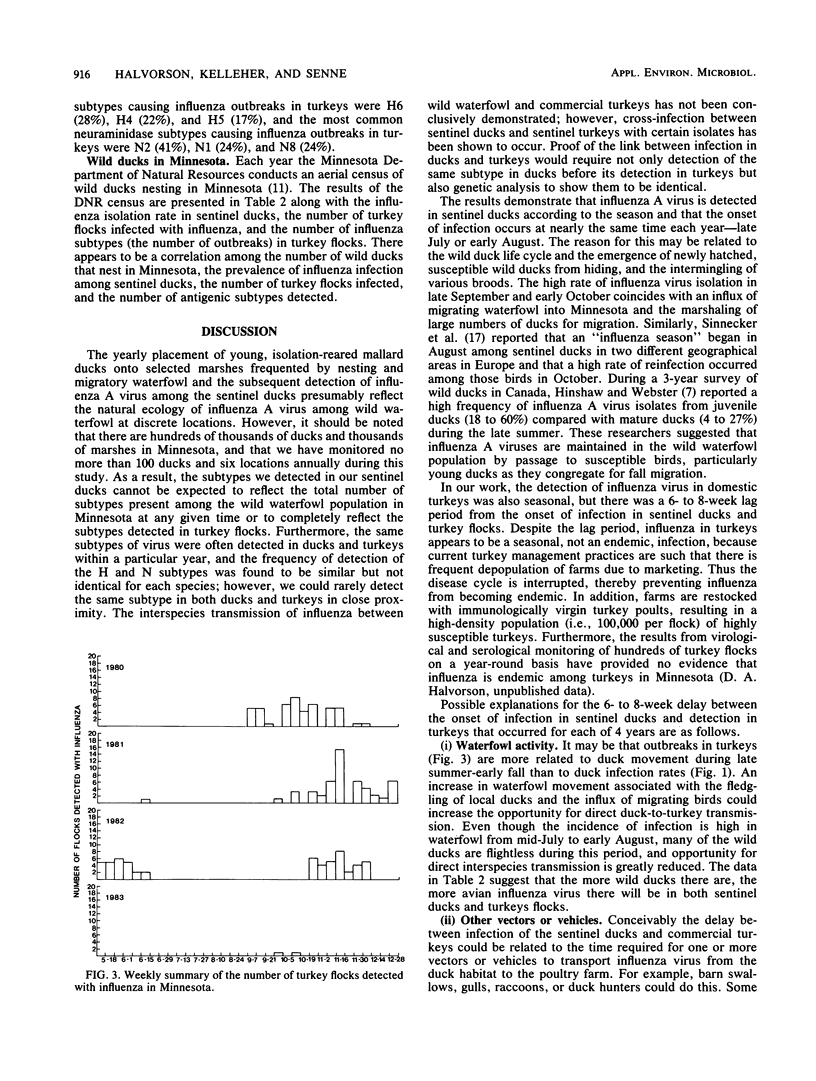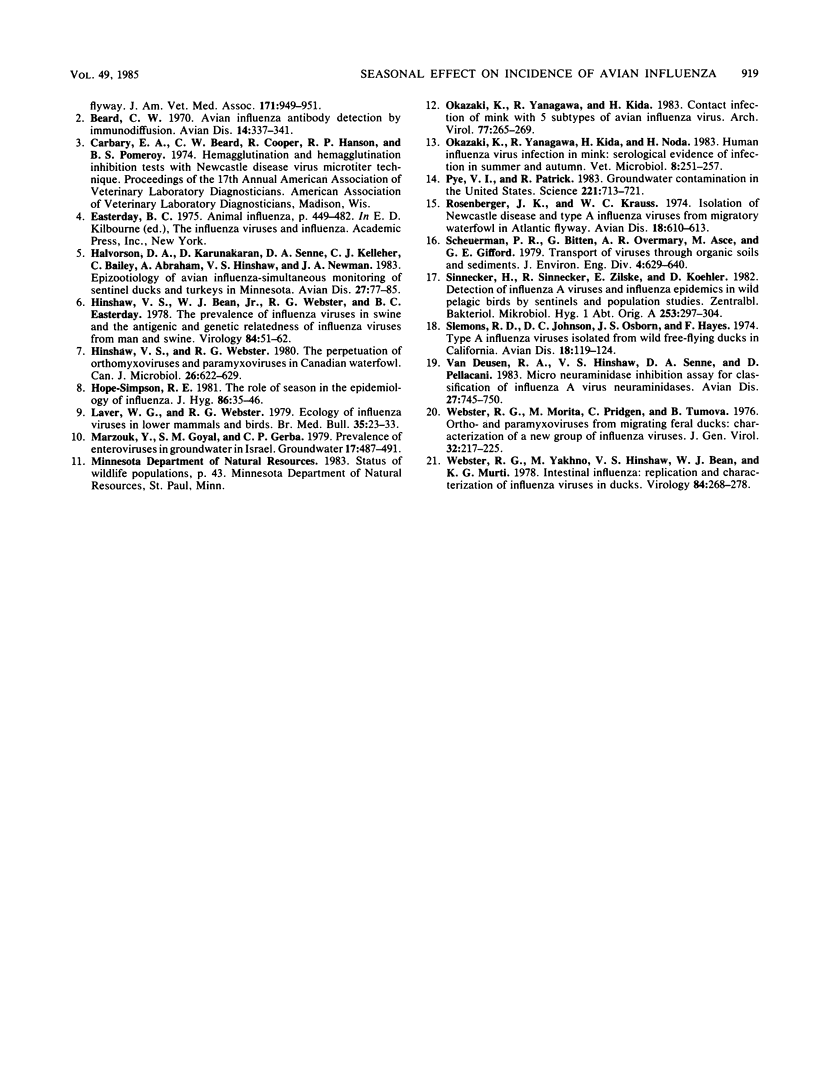Abstract
Sentinel ducks and domestic turkey flocks were monitored for influenza infection during a 4-year period. The onset of infection among ducks was similar each year, occurring in late July or early August. Influenza in turkeys was also shown to be seasonal, but the usual onset was 6 to 8 weeks after the detection of influenza in sentinel ducks. Possible explanations for the delayed infection in turkeys are (i) increased waterfowl activity associated with fledging and congregating in late summer and early fall; (ii) vectors transmitting virus from the waterfowl habitat to poultry farms; (iii) cooler environmental temperature, allowing prolonged virus viability; (iv) cooler surface water temperature, allowing prolonged virus viability; (v) groundwater contamination from contaminated surface water; and (vi) virus adaptation in domestic turkeys before infection is detected. We conclude that ducks are not only a natural reservoir of influenza but also have a seasonal infection that appears to be related to seasonal influenza outbreaks in domestic turkeys in Minnesota. However, only some influenza A virus isolates circulating among waterfowl at any given time appear capable of causing detectable infection in turkeys. It is speculated that the seasonal infection in migratory waterfowl may also be related to seasonal influenza infections in other species including humans.
Full text
PDF





Selected References
These references are in PubMed. This may not be the complete list of references from this article.
- Bahl A. K., Pomeroy B. S., Mangundimedjo S., Easterday B. C. Isolation of type A influenza and Newcastle disease viruses from migratory waterfowl in the Mississippi flyway. J Am Vet Med Assoc. 1977 Nov 1;171(9):949–951. [PubMed] [Google Scholar]
- Beard C. W. Avian influenza antibody detection by immunodiffusion. Avian Dis. 1970 May;14(2):337–341. [PubMed] [Google Scholar]
- Halvorson D., Karunakaran D., Senne D., Kelleher C., Bailey C., Abraham A., Hinshaw V., Newman J. Epizootiology of avian influenza--simultaneous monitoring of sentinel ducks and turkeys in Minnesota. Avian Dis. 1983 Jan-Mar;27(1):77–85. [PubMed] [Google Scholar]
- Hinshaw V. S., Bean W. J., Jr, Webster R. G., Easterday B. C. The prevalence of influenza viruses in swine and the antigenic and genetic relatedness of influenza viruses from man and swine. Virology. 1978 Jan;84(1):51–62. doi: 10.1016/0042-6822(78)90217-9. [DOI] [PubMed] [Google Scholar]
- Hinshaw V. S., Webster R. G., Turner B. The perpetuation of orthomyxoviruses and paramyxoviruses in Canadian waterfowl. Can J Microbiol. 1980 May;26(5):622–629. doi: 10.1139/m80-108. [DOI] [PubMed] [Google Scholar]
- Hope-Simpson R. E. The role of season in the epidemiology of influenza. J Hyg (Lond) 1981 Feb;86(1):35–47. doi: 10.1017/s0022172400068728. [DOI] [PMC free article] [PubMed] [Google Scholar]
- Laver W. G., Webster R. G. Ecology of influenza viruses in lower mammals and birds. Br Med Bull. 1979 Jan;35(1):29–33. doi: 10.1093/oxfordjournals.bmb.a071537. [DOI] [PubMed] [Google Scholar]
- Okazaki K., Yanagawa R., Kida H. Contact infection of mink with 5 subtypes of avian influenza virus. Brief report. Arch Virol. 1983;77(2-4):265–269. doi: 10.1007/BF01309274. [DOI] [PubMed] [Google Scholar]
- Okazaki K., Yanagawa R., Kida H., Noda H. Human influenza virus infection in mink: serological evidence of infection in summer and autumn. Vet Microbiol. 1983 Jun;8(3):251–257. doi: 10.1016/0378-1135(83)90077-9. [DOI] [PubMed] [Google Scholar]
- Pye V. I., Patrick R. Ground water contamination in the United States. Science. 1983 Aug 19;221(4612):713–718. doi: 10.1126/science.6879171. [DOI] [PubMed] [Google Scholar]
- Rosenberger J. K., Krauss W. C., Slemons R. D. Isolation of Newcastle disease and type-A influenza viruses from migratory waterfowl in the Atlantic flyway. Avian Dis. 1974 Oct-Dec;18(4):610–613. [PubMed] [Google Scholar]
- Sinnecker H., Sinnecker R., Zilske E., Koehler D. Detection of influenza A viruses and influenza epidemics in wild pelagic birds by sentinels and population studies. Zentralbl Bakteriol Mikrobiol Hyg A. 1982 Dec;253(3):297–304. [PubMed] [Google Scholar]
- Slemons R. D., Johnson D. C., Osborn J. S., Hayes F. Type-A influenza viruses isolated from wild free-flying ducks in California. Avian Dis. 1974 Jan-Mar;18(1):119–124. [PubMed] [Google Scholar]
- Van Deusen R. A., Hinshaw V. S., Senne D. A., Pellacani D. Micro neuraminidase-inhibition assay for classification of influenza A virus neuraminidases. Avian Dis. 1983 Jul-Sep;27(3):745–750. [PubMed] [Google Scholar]
- Webster R. G., Morita M., Pridgen C., Tumova B. Ortho- and paramyxoviruses from migrating feral ducks: characterization of a new group of influenza A viruses. J Gen Virol. 1976 Aug;32(2):217–225. doi: 10.1099/0022-1317-32-2-217. [DOI] [PubMed] [Google Scholar]
- Webster R. G., Yakhno M., Hinshaw V. S., Bean W. J., Murti K. G. Intestinal influenza: replication and characterization of influenza viruses in ducks. Virology. 1978 Feb;84(2):268–278. doi: 10.1016/0042-6822(78)90247-7. [DOI] [PMC free article] [PubMed] [Google Scholar]


